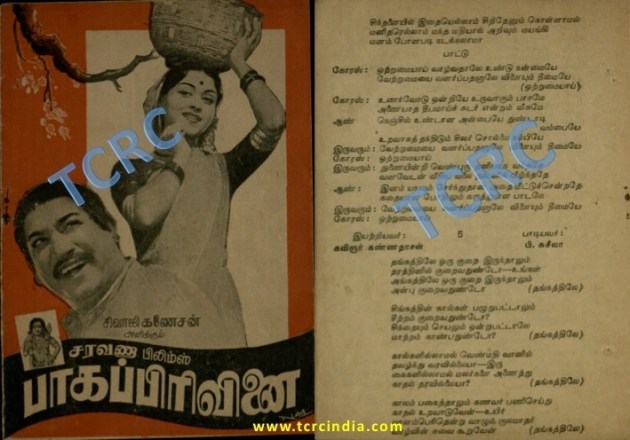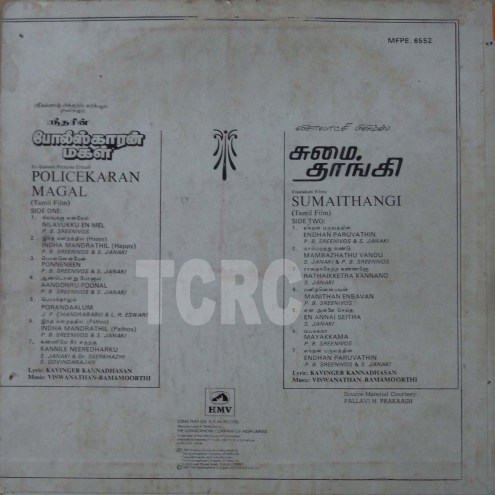By P.V. Gopalakrishnan
In this second part on ‘Exotic Instruments’ that have been used in our film music, we would cover some more instruments.
Mandolin, a 17th century evolved Italian instrument, with traditionally four courses of double strings, had featured prominently in almost all film music compositions till late sixties.
Among the multitude of songs using Mandolin here is the popular song ‘Neela vanna kannane’ from the film Mallika (1957), in the music of T.R.Paapa.
Mandolin used to be in most of MSV-TKR compositions, having been played by the Legend M.S.Raju. M.S.Raju was a dominant & very senior member of MSV’s orchestra as the man of many parts as he played Mandolin & Santoor besides whistling & doing konnakol.
Listen to ‘Thangathile oru kurai irunthalum’ (Bagapirivinai – 1959) in the beautiful mukhda of the song, in M.S.Raju’s Mandolin.

Song book of Bagapirivinai with the page containing the song THANGATHILE ORU KURAI PC: From the archives of TCRC
Santoor: is a Kashmiri instrument with seventy two strings and M.S.Raju as well as R.Visweswaran used to play Santoor for MSV.
It was Music Director Naushad, who made people to sit back & take note of this scintillating instrument in the song ‘Mere mehboob thuje’ from the film ‘Mere Mehboob’ (1963), when this instrument attracted attention of many.
The beautiful, reflective santoor used to be common in the BGM of many films, often as a gentle romantic hint in the score during the maiden romantic encounter.
Here is Santoor played by M.S.Raju in the song ‘Aaru maname aaru’ from ‘Andavan Kattalai’ (1964), in MSV-TKR composition.
You can also catch Santoor notes even in Ilayaraja’s ‘Chinna kannan azhaikkiran’ (Kavi Kuyil) in the opening BGM.
Sarangi, a bowed short-neck stringed instrument famed for its close imitation of the human voice, was rarely used in Tamil film songs. But wherever exceptionally used, they lent brilliant emotive grains to the song, as in ‘Ullathil nalla ullam’ from ‘Karnan’ (1964) in the composition of MSV-TKR. For this film MSV had brought musicians from the North.
There is an Instrument called Dilruba/Esraj, from Punjab, which sounds similar to the melancholic strains of Sarangi. The most famous exponent on Dilrupa in Tamil film industry was Dilruba Shanmugham who has played in-numerous scores for legends like MSV and Ilayaraja.
The lilting song, ‘Chinna thai aval’ from Thalapathi by Ilayaraja had Dilruba bits in it.
Sarod, a lute-like instrument from Afghanistan that rose to prominence in the Mughal courts too have featured in films, but exceptionally in Tamil films. The Sarod is highly versatile–when played quickly it can denote excitement and movement, and when plucked slowly it can touch your heart.
Here is a Tamil film song ‘Devan kovil maniyosai’ from the film ‘Mani osai’ (1963) in the music of MSV-TKR where Sarod appears twice in the song, post anthra, just after the flute.
The mesmerizing jugal bandhi between Sitar, Jaltarang and Sarod could be heard in the last portions “Madhuban Mein Radhika” (Kohinoor- 1960), composed by the legend Naushad.
Sitar, a multi-string plucked instrument that influenced the Western pop world in the 1960s (thanks to Pandit Ravi Shankar), when The Beatles and Rolling Stones adopted it. Tamil film music too has used it in songs & BGM.
Mr. Janardhan is a well known Sitar player who had played for film music too.
Sridhar’s ‘Nenjil oar Aalayam’ (1961) featured Sitar in its songs, in the composition of MSV-TKR.
Other notable songs in Tamil with Sitar notes included ‘Kettadhum koduppavane Krishna’ from Deiva Magan (1969) composed by MSV & ‘ennathan ragasiyamo’ from Idhaya Kamalam (1965) composed by K.V.Mahadevan.

Song book of Idhaya Kamalam with the page containing the song ENNATHAN RAGASIYAMO PC: From the archives of TCRC
In Hindi, there are many songs featuring Sitar, one of which is the beautiful composition of Salil Chowdhri ‘Oh Sajna’ from the film Parakh.
Another classical based film song in Hindi featuring Sitar was ‘Tere bina zindagi main’ from Andhi composed by R.D.Burman.
Violin, a highly popular bowed four stringed Italian instrument with roots in 16th century Italy, has had global impact, including in orchestral performances of Indian film music, in a big way.
Violins are an integral part of film music orchestration. I’ve listed several songs that highlight its use as a solo instrument, or more commonly as part of a large orchestra seen in numerous Indian film songs.
In each cinema orchestra there will be a ‘First Violinist’ who leads the song along with the vocalist, without over powering the singer. Henry Daniels & V.S.Narasimhan were with MSV-TKR & Ilayaraja, respectively as First Violinists.
Then, of course, the cine orchestra would have a big collection of violinists.
Here are samples of how collective violin players contribute to the compositions. Here is ‘Poga poga theriyum’ from Server Sundaram where violin score has been very briskly & beautifully contrived by the music arrangers.
Shehnai, a double reeded wind instrument made out of wood with wooden flared bell at the other end, has been commonly used in Indian film music.
MSV-TKR had in their orchestra, Satyam whose delectable Shehnai notes could be heard in some of their compositions such as ‘Malai pozhuthin mayakkathile’ (Bagyalakshmi), ‘Avalukkum Thamizh enru paer’ (Panchavarnakili), “Alaya maniyin osaiyai naan’, ‘Ennai yar enru’ (Palum Pazhamum) ‘Kuthu vilakkeriya’ (Pachai Vilakku) & ‘Oru naal iravu’ (Kaviya Thalaivi).
Satyam was an asset to MSV-TKR. There was an episode when recording for Kaviya Thalaivi since MSV could not get what he wanted out of Satyam, resulting in multi takes, Satyam when he retired home after the work denied food from his wife & MSV had to call him up and cajole him!
Oboe, a double reed wood instrument like clarinet, but of treble range of musical notes, has also been used on & off in Tamil Film music.
A classic example is ‘Kanna karumai nira kanna’ from Naanum Oru Penn, in the composition of Sudarsanam in which oboe features.
Flute, an ancient instrument comes in different octaves as well as different pipe construction such as bamboo, metal etc. The traditional bamboo flutes of different sruthis (tonal variations) along with Piccolo Flutes (used in Symphonies) & Shakuhachi (Japanese Flutes) have been associated with pastoral compositions in Indian films.
MSV-TKR had an important orchestra member in Nanjundappa, the flautist. Listen to one of his chirpy works in the very beautifully composed melody ‘Indha manrathil oadi varum’ (Policekaran Magal).
In ‘Chingari Koi Bhadke’ – Amar Prem, composed by R.D.Burman, one can hear the rich & moving notes of a Bansuri flute of bamboo make usually used to signify a tragic or devotional flavours, transporting the listener to a different world.
Who can forget the beautiful flute piece in ‘Chinna kannan azhaikkiran’ (Kavi Kuyil) composed by Ilayaraja, as it seamlessly takes over from the Santoor bit & vioilin serande in the song.
‘Naan manthoppil’ by L.R.Easwari in the film ‘Enga veettu pillai’ (1965) features the shrill Picollo flute which has very high registry.
There are innumerable Tamil film songs embodying delectable flute notes, which are very pleasurable to listen but it would be impractical to mention all of them.
We will continue discussing more of the exotic musical instruments used in our films in our next posting too.



